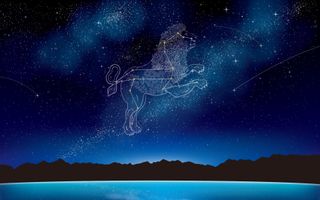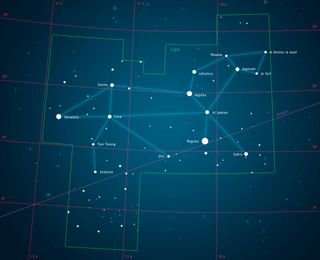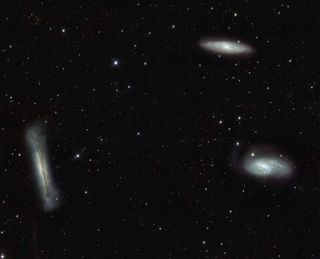Leo constellation: Facts, location, and stars of the lion
The constellation of Leo is one of the easiest to spot over Earth inspiring both mythology and cutting-edge astronomy.

One of the most prominent constellations of the night sky, Leo the Lion is visible from pretty much anywhere on Earth, except for Antarctica. This means humanity has founded a wealth of myths and legends around the constellation.
In the modern age, Leo is the home in the sky of a wealth of objects of great scientific interest meaning skywatchers and astronomers today are as fascinated with the lion as were antiquity's astrologers and myth-weavers.
Leo is part of the twelve constellations that comprise the zodiac with the others being Aries, Taurus, Gemini, Cancer, Virgo, Libra, Scorpius, Sagittarius, Capricornus, Aquarius, and Pisces. It follows the naming convention of these groupings taking its name from an animal.
Related: Night sky guide: What you can see tonight [maps]
Most of the zodiac constellations are named after animals or mythological people, with only Libra, the scales, bucking this trend by taking the name of an inanimate object.
Unlike some of the other constellations, Leo is recognizable as it actually looks like its namesake composed of a "head" and "mane" shaped sickle, or backward question mark, of stars, and haunches composed of a triad of stars.
Where is the Leo constellation?
Right ascension: 11 hours
Declination: 15 degrees
Visible between latitudes: 90 and minus 65 degrees
Best seen: April at 9 p.m.
Leo is the 12th largest of all the constellations and in terms of the night sky, taking up up an area of around 947 square degrees. The constellation is visible at latitudes between +90⁰nd -6⁵⁰ according to the skywatching website "Constellation Guide".
The lion is also one of the 15 "equatorial constellations," constellations intersect the celestial equator, the great circle of the celestial sphere which is on the same plane as the equator of Earth. As result constellations like Leo are visible from most locations on Earth, but only at specific times of the year.
In the northern hemisphere, the constellation of Leo is easily seen during spring, particularly around the spring equinox during the months of March, April, and May. It can be seen soon after sunset and for most of the night.
As spring progresses into summer Leo drifts progressively to the west, by late July or early August Leo fades into the sunset.
Leo lies between the constellations Cancer to the west and Virgo to the east at 11 hours right ascension and 15° north declination. Its other non-zodiac constellation neighbors are Coma Berenices, Crater, Hydra, Leo Minor, Lynx, Sextans, and Ursa Major.
The constellation can be found by looking for the head of the lion, or the "sickle," starting at the Regulus (Alpha Leonis) star. Regulus, Al Jabbah, and Algieba, together with the fainter stars ζ Leo (Adhafera), μ Leo (Ras Elased Borealis), and ε Leo (Ras Elased Australis), constitute the sickle.
The brightest star in the curve of the sickle is Al Geiba, which means "the lion's mane." In January 2001, a large object eight times the size of Jupiter was discovered orbiting Al Geiba. A triangle of stars forms the lion's haunches. The brightest star of this trio is Denebola, which means "tail of the lion."
There are a number of luminous galaxies within Leo, including the Leo triplet of M66, M65 and NGC 3628. The Leo Ring, a cloud of hydrogen and helium gas, orbits of two dwarf galaxies.
Leo observing targets

Leo is one of the easiest constellations to spot and the best way to start is by looking for its bright blue-white star Regulus or "Alpha Leonis." Located at the bottom of Leo's backward question-marked sickle from Regulus skywatchers can trace out the head of Leo by spotting its second brightest star and the brightest in the curve of the sickle, Algeiba, which means "the lion's mane."
The rest of the sickle of Leo, visible to the southeast after sunset, is made up of the fainter stars ζ Leo (Adhafera), μ Leo (Ras Elased Borealis), and ε Leo (Ras Elased Australis).
Looking at the sickle star Algeiba, also known as Gamma Leonis, with a telescope reveals that it is actually composed of two bright stars located around 130 light-years away, one an orangy red, the other yellowish in color.
After spotting the lion's head, skywatchers may next want to trace its haunches and its tail, which are formed by a triangle of stars the brightest of which is Denebola, or the "tail of the lion."
Stars aren't the only astronomical body comprising Leo, the constellation is also made up of several bright galaxies. The most notable of these is the Leo triplet made up of the spiral galaxies Messier (M66), Messier 65 (M65), and NGC 3628.

The three galaxies don't just appear close together in the night sky, they are actually gravitational bound dwelling around 35 million light-years from Earth.
Also within the Leo constellation is a giant primordial cloud of gas that is large enough to form a galaxy. Discovered in 1983 and resembling nothing astronomers had ever discovered before, this cloud has been named the Leo Ring. Composed of mostly molecular hydrogen, the Leo Ring is so vast it is six times wider than the Milky Way.
The Leo Ring orbits two dwarf galaxies in the constellation and has become something of a puzzle to astronomers as it is large and dense enough to have collapsed to form its own stars, but for some reason hasn't.
One suggested origin for the Leo right is the collision of the galaxies NGC 3384 and Messier 96 1.2 billion years ago expelling a galaxy-sized amount of gas into intergalactic space.
The constellation of Leo is also home to the radiant point, the point from which meteors appear to originate, of the Leonid meteor shower, which occurs each year around November as Earth passes through the debris left by Comet Tempel-Tuttle.
Related: Meteor showers 2023: Where, when and how to see them
The mythology of Leo
In terms of astrology, Leo is the fifth sign of the Zodiac and is considered to govern the period of around July 23 to August 22. It is one of the three fire signs of the Zodiac ruled by the sun.
Of the mythological tales associated with the constellation of Leo, arguably the best known is Hercules' battle with the Nemean lion. A fierce monster of Greek mythology, Hercules or Heracles had to battle the beast as part of his first of 12 labors.
The Nemean lion was so feared because while its golden mane protected it from any assault, its claws were sharper than any weapon forged by humanity. Hercules defeated the lion when Athena instructed him to use the lion's own claw as a weapon against it.
Leo was an important constellation to the ancient Egyptians who associated it with the flooding of the Nile. This event occurred during the hottest time of year, also when the sun entered Leo. The flooding of the Nile was a good omen as, according to National Geographic, the event was for thousands of years a source of irrigation transforming arid and dry land into fertile regions. This means they held Leo in high regard.
Additional resources
One of the most exciting targets for astrophotographers in the constellation of Leo are the galaxies that make up the Leo triplet. AstroBackyard explains how to get a stunning image of this triad of galaxies.
Bibliography
Celestial Wonders in Leo, Night Sky Network, NASA, [Accessed 12/13/22], [https://nightsky.jpl.nasa.gov/news-display.cfm?News_ID=948]
Leo Constellation, Constellation Guide, [Accessed 12/13/22], [https://www.constellation-guide.com/constellation-list/leo-constellation/]
Leo, Britannica, [Accessed 12/13/22], [ https://www.britannica.com/place/Leo-constellation]
A 40-year-long mystery: heavy elements unveil the origin of the giant Leo Ring, ESO, [2021], [https://www.eso.org/public/blog/heavy-elements-unveil-origin-of-leo-ring/]
Nile River, National Geographic, [https://education.nationalgeographic.org/resource/nile-river]
Join our Space Forums to keep talking space on the latest missions, night sky and more! And if you have a news tip, correction or comment, let us know at: community@space.com.
Get the Space.com Newsletter
Breaking space news, the latest updates on rocket launches, skywatching events and more!

Robert Lea is a science journalist in the U.K. whose articles have been published in Physics World, New Scientist, Astronomy Magazine, All About Space, Newsweek and ZME Science. He also writes about science communication for Elsevier and the European Journal of Physics. Rob holds a bachelor of science degree in physics and astronomy from the U.K.’s Open University. Follow him on Twitter @sciencef1rst.
